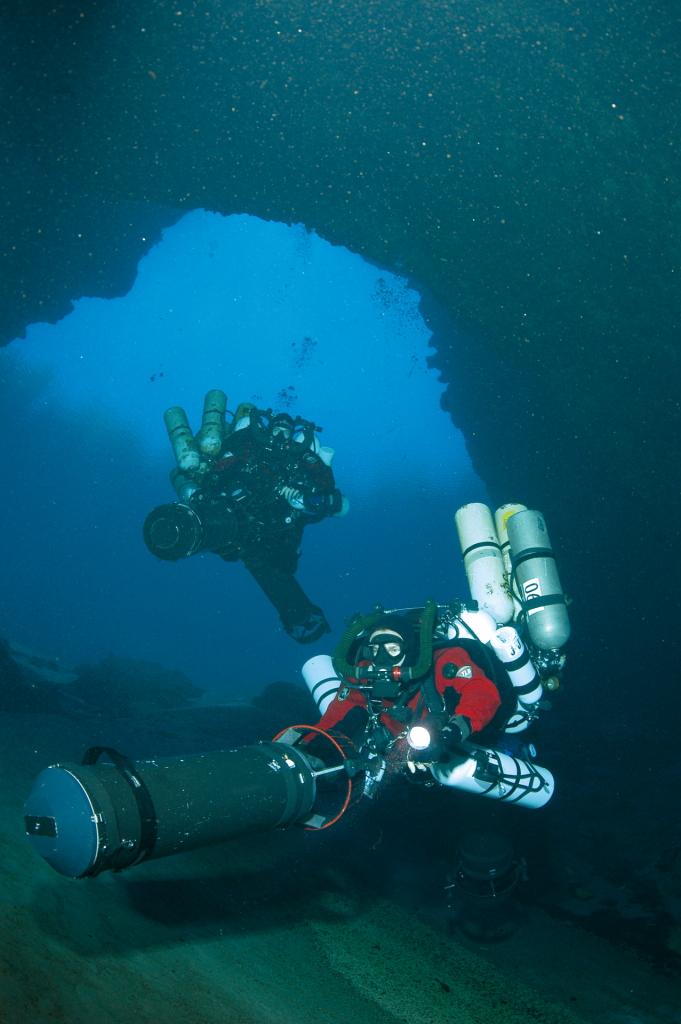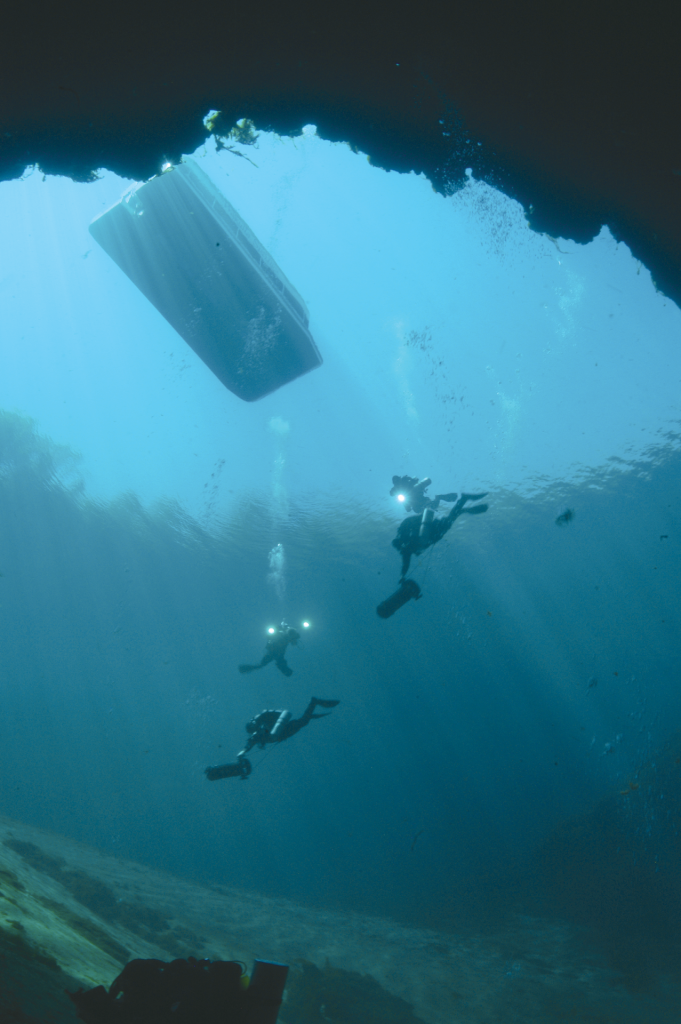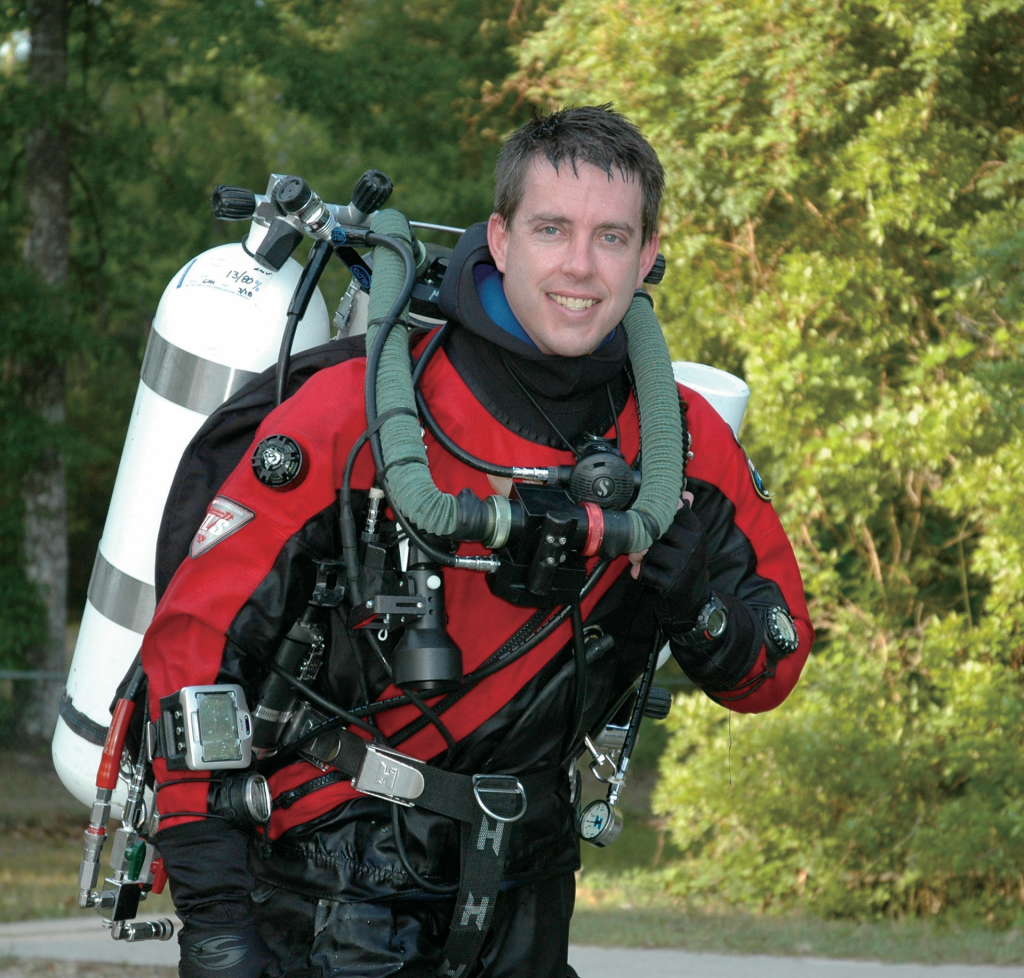“What’s left to explore?” The question was swimming around in my head as I cycled to my office. The highest mountains have been scaled, the world has been circumnavigated by land, air and sea, and there is nary a corner of the globe that hasn’t been trampled with thick-soled, Gore-Tex boots and probed with high-definition video cameras.

Human beings seem fixated on exploration and, while we seem to have a celestial inclination to look to the sky in search of new frontiers, the answer may actually lie beneath our feet. I considered this as I was about to meet Casey McKinlay, because the subterranean is his specialty. He, along with his good friend and dive partner Jarrod Jablonski, is the current world record holder in cave diving.
If you were like me and not sure what that means, consider spending your next weekend underwater exploring a dark cave. Sound kinda cool? How about for 26 hours straight? Oh, and for about 16 of those hours you’ll be hanging out a few meters below the surface decompressing, hoping your dive buddy brought some good music on the iPod you are sharing.
The decompression process is crucial to push the nitrogen out of your system and avoid decompression sickness (or narcosis) before you can pop up for some fresh air.
But, to members of the Woodville Karst Plain Project (WKPP), this is living. The group of dedicated technical divers spends every free weekend exploring and mapping caves in Florida, which is home to the largest underwater cave system in the United States, and the fourth largest in the world.

McKinlay has been a member of the WKPP since 1993. He was in Japan for the first time for a quick stop on his way to Korea to do a training seminar for Halcyon, the technical diving equipment company for which he is a spokesperson when he’s not diving himself.
Sitting outside in the sun at the Outdoor Japan office in Tokyo, Casey talked about the spirit of exploration, which is at the very core of cave diving. “If you aren’t exploring and mapping new terrain, it’s a waste of a dive; it basically doesn’t count,” he explains.
So what drives this small, hardcore group of specialists within the diving community to push themselves to the brink of their physical limits in the name of exploration?

How did you get into cave diving?
I took a recreational diving class in college and, at the end of the course, they take you out for a dive. My dive happened to be out at the springs (outside of Gainesville, Florida). At the bottom of most springs is an entrance to a cave. I went back to explore it and have been cave diving ever since.
How does a recreational diving differ from caving?
A “rec” dive usually lasts 30-45 minutes. A normal cave dive lasts one to two hours, and often much longer. I’ve been out for up to 27 hours. Cave diving is all about distance, as we are constantly surveying and mapping new territory.
What are the hot spots for cave diving?
Northern Florida is probably the most active in the world. The WKPP has about 75 members diving regularly. The three largest caving systems are all in Mexico. It has really exploded down there the last five to 10 years. Yucatan has the largest known cave system in the world. Australia has active cave diving, although in some remote areas such as the Nullarbor Plain. Spain, France, Italy and, to a lesser extent New Zealand, have cave diving.
What about here in Asia?
Asia is fairly untapped. There are limestone caves and dry caves to explore, and Japan has sea caves and lava caves too.
What makes Northern Florida so popular?
The best part is simply the access. Many caves are in state parks where people can swim or dive. Although a number of Florida parks allow recreational diving access for trained divers, several only allow access via a special permit which can be difficult to obtain.
How have things changed since the early days of cave diving?
The biggest difference is the knowledge, equipment and technology available. The equipment today is more robust, durable and dependable.
That’s how I got involved with Halcyon – the necessity to develop new equipment for cave diving and technical diving was the reason the company was formed back in 1996 and what drives it today.
Cave diving is all about depth and distance. You go deep and then you go in. You depend a lot on your equipment, so it has to be good.
The lighting systems have improved tremendously; not only duration and reliability but also the focus and intensity of the beam. In the early days, the beam dissipated a lot. Ten years ago, Halycon lights lasted about two and a half hours. Today they reach 13 hours.
There is better nutrition planning now, and our knowledge and standardization of breathing “gasses” has improved too. We’ve fine-tuned the gas mixes, allowing us to stay down longer. On my previous world-record dive, we used seven gas mixtures.
Basically, in the old days, there were a lot of unknowns, a lot of trial and error, as we sorted out how to do the dives, since we were the first to do them.
Aren’t there times you want to take a break on long dives?
Yes, we actually have underwater habitats we use on long dives. We use a tank to fill them with air, its great to take off your mask for a few minutes, eat some (hopefully dry) food and take a break. The new guys usually have to pull in the habitats if they aren’t already in the cave.
The small ones have just enough room for your head and shoulders, larger ones you can crawl up into, have a couple shots of Starbucks, clear your head and have a snack.
Aren’t the caves difficult to navigate?
Many of the caves are like mazes. It took us 10 years to map out and connect Wakulla Springs, one of the largest springs in Florida. We have reels with line for safety. We tie in when we enter and follow the line back out. We also use two Halcyon re-breather units for each diver; we leave one back by the entrance to be used during decompression.
Diver Propulsion Vehicles (DPV) are used to move around, so we don’t use up “trimix” exerting energy. Pure oxygen deeper than 10 meters is deadly, so the mix we use deep is usually a 10% oxygen and 85% helium trimix. On some dives, we’ll use up to six DPV for each diver.
What are some common traits of cave divers?
I find most are calm and collected, well prepared and love exploring. And they are able to push themselves hard.
Other than pure exploration, what’s been one of your most rewarding experiences cave diving?
In one case, one of the largest springs in Florida, Wakulla Springs, was becoming polluted and people couldn’t understand where it was coming from. We helped isolate the source of the pollution and discovered it originated from Tallahassee nearly 20 miles away.
It took just 60 days for the pollution to go 20 miles to the spring, and the cave we were diving. Treated water quickly passed through sand, limestone and then into the caves, carrying water to the spring. We helped do research and discover the source of the pollution. As a result, the city approved spending $200 million for additional treatment procedures (beyond the standard).
The public really got involved and wanted to do the right thing despite the costs. It was extremely satisfying to have a positive impact on our local environment.
Is there anything you have to especially look out for?
Unpredictable weather. Rain can affect visibility and increase the risk. That and your friend’s music selection if you are sharing an MP3 player.
After an exhausting 20-hour dive, what gets you back in the water?
I love the process, the teamwork and the satisfaction of discovering places where no one has ever been before. And simply the sensation of flying through massive underwater canyons and rock formations 20-30 meters in diameter in virgin caves.
Editor’s Note: On June 13, 2008, Casey McKinlay and Jarrod Jablonski returned to Wakulla and blew away their previous distance record with a 27-hour, 25,766-feet world record push south from Wakulla Springs toward the Gulf of Mexico. To quote Casey, “(It was) one hell of a dive.”
Casey and Jarrod were recently admitted as “Fellows” of the prestigious Explorers Club for their efforts with WKPP. Web: www.explorers.org.
What is ‘tech’ diving?
Tech diving is defined as scuba diving beyond recreational limits. It takes several forms such as cave diving, deep diving, decompression diving and wreck (penetration) diving. In each type of diving, direct ascent to the surface is impossible due to the overhead environment or the need for decompression.
Helium-based breathing gases are required when diving deeper than 30 meters to avoid narcosis (too much nitrogen in the blood stream). Therefore, in addition to fundamental diving skills, tech diving requires vigorous training and special equipment.
Why tech diving?
Although most divers dive simply because it is fun, some do it to relax, others to socialize, some for underwater photography. Tech divers are driven by the curiosity to see beyond the next corner. They are explorers.
These divers have a need to go deeper, stay under longer and enter overhead environments recreational divers wouldn’t try. There are several wrecks and caves in Japan only possible to dive safely as a tech dive.
Where to get training?
There are several organizations providing tech diving in Japan, however Global Underwater Explorers (GUE) was founded by explorers, scientists and conservationists and remains committed to discovery and education. All WKPP divers are GUE trained. The training has helped WKPP not only hold all the world records in cave diving, but also keep an excellent safety record.
How to start tech diving in Japan?
The GUE Fundamentals introductory training curriculum is designed to develop a solid foundation of basic diving skills and is a pre-requisite for further GUE tech and cave training. There are only 60 certified GUE Instructors teaching worldwide.
In Japan, GUE Instructor Thomas Jonsson of Japan Underwater Explorers (JUE) teaches this course. JUE also runs recreational and tech dive trips in Japan as well as international tech and cave diving expeditions.
WEB CONNECTION
Technical Diving
Global Underwater Explorers: www.gue.com
Japan Underwater Explorers: www.jue.jp
Halcyon: www.halcyon.net
Woodville Karst Plain Project: www.wkpp.org
Recreational Diving in Japan
Japan Underwater Explorers (Tokyo): www.jue.jp
Discovery Divers (Tokyo): www.discoverydiverstokyo.com
Reef Encounters (Okinawa): www.reefencounters.org




